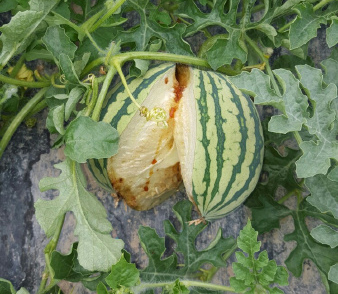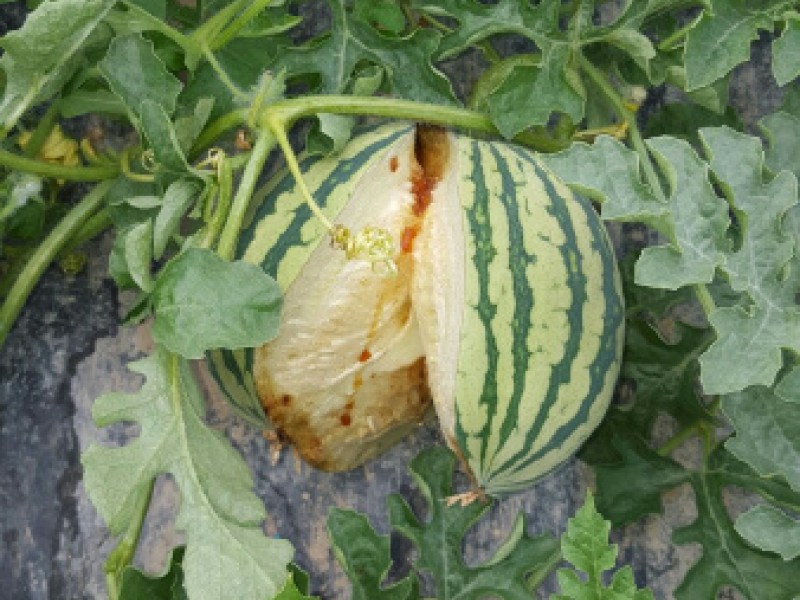Cucumber vein yellowing virus CVYV

This disease, transmitted by the white fly, Bemisia Tabaci, affects cucurbitaceae such as the cucumber, courgette, melon or watermelon
The disease known as “Cucumber vein yellowing virus” (CVYV) is transmitted through the adult individuals of the whitefly (Bemisia tabaci) and affects cucurbitaceae species such as the cucumber, courgette, melon or water melon.
It was located for the first time in 1960 in cucurbitaceae cultivated in Israel. It appears to be related to the sweet potato mild mottle virus (SPMMV). It is wide-spread in Western Mediterranean countries, and since 2001 it affects the fields of Andalusia.
Symptoms of the vein yellowing virus
In cucumber and melos: Yellowing of the veins is observed in the leaves of the shoot, a characteristic whence the virus derives its name, although, depending on the moment of infection, this yellowing can also occur in a generalised manner in the entire plant. The plant development is also less.
In cucumber fruit, a light green, dark green, mosaic occurs, whilst no symptoms occur in melon fruit.
 It seems that this virus, associated with the cucurbit yellow stunting disorder virus (CYSDV), produces a synergism that boosts the symptoms of both virus
It seems that this virus, associated with the cucurbit yellow stunting disorder virus (CYSDV), produces a synergism that boosts the symptoms of both virus
In courgette: The symptoms observed on the leaves are a slight yellowing of the veins.
In watermelon: In leaves where it has been detected, the chlorosis symptoms are very mild and may go unnoticed. At times, they are even symptom-free. A strong internal necrosis has been observed in the fruit, as well as splitting of this fruit, which is attributed to the virus, although whether this is a unique and/or direct consequence has not been entirely demonstrated.
Transmission of the vein yellowing disease
The virus is transmitted by the vector insect, Bemisia Tabaci (Homoptera: Aleyrodidae). The adults of this whitefly can be observed on the backs of the leaves like small insects that measure somewhat more than 1 millimetre long with a yellowish body and white wings due to the secretion of waxes that covers them.
A virus acquisition period of at least 30 minutes is needed, and at least 15 minutes feeding on the plant is required to inoculate it. The insect retains the virus for 6 hours and has a latent period of 75 minutes. Low transmission effectiveness by the Bemisia Tabaci has been indicated, and at least 15 to 20 insects are required per plant for its transmission.
Methods to combat Bemisia Tabaci
The management methods are based mainly on controlling the Bemisia Tabaci vector by means of prevention and culture practices (use of meshes, elimination of plant waste, use of resistant varieties, use of certified virus-free material, …), as well as plant health and integrated management practices.
The Regional Ministry of Agriculture and Fishery of the Junta of Andalusia, advises a series of specific measures:
- Placement of double mesh on the edges and ridges of the greenhouses and placement of double door or mesh at the entrance.
- When the climate conditions (especially humidity) permit adequate ventilation of the greenhouse, placement of anti-trip meshes.
- Use of yellow chromotropic traps.
- Surveillance and control of the white fly in early cultivation stages and seed beds.
- Set up the measures relating to cleaning plant remains and weeds in the greenhouse and surrounding areas. Pull out and immediately eliminate plants affected by the virus during cultivation.
- Not abandoning the crops and carrying out treatment against Bemisia Tabaci before pulling them out is compulsory as a management method, as well as correctly eliminating the plant remains.
- Leave a rest period of at least one month between one cucurbitaceae crop and the next one to break the cycle of whitefly.
To control the whitefly in the framework of the integrated management of pests, natural specialised plant health products that have proved to be very effective in eradicating Bemisia Tabaci can be resorted to, as is the case of Pirecris.
Source: Consejería de Agricultura y Pesca. Andalucía. fitodiagnostico.com

